|
|
|
Sort Order |
|
|
|
Items / Page
|
|
|
|
|
|
|
| Srl | Item |
| 1 |
ID:
138501
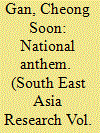

|
|
|
|
|
| Summary/Abstract |
This article examines the discourse surrounding the disrespect shown to the National Anthem in Malaysia during the first decade of independence. Initially, those who refused to stand silently when the Anthem was played were characterized as rude and/or ignorant of the new responsibilities of citizenship. However, the discourse was eventually submerged into the wider and continuing contestation over the meaning of this newly independent nation, and those showing disrespect for the Anthem were racialized and accused of disloyalty to their nation. This article argues that, while a national anthem may be a symbol that resonates with a citizenry due to music’s potential as a vessel of emotional (and national) expression, it is precisely an anthem’s performative nature that makes it an unstable and malleable symbol of national identity, vulnerable to varying interpretations of the meaning of the nation.
|
|
|
|
|
|
|
|
|
|
|
|
|
|
|
|
| 2 |
ID:
185328
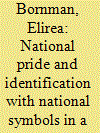

|
|
|
|
|
| Summary/Abstract |
The article investigates national pride, identification with national symbols and predictors of national pride some 20 years after South Africa’s political transformation. The results of a questionnaire survey involving a countrywide probability sample of 3 608 respondents are compared with those of a 1998 study. Compared to the 1998 study, there was a decline in national pride, while identification with national symbols increased. Particularly noteworthy were increases among Afrikaans-speaking Whites who dis-identified with national symbols in 1998. Significant group differences were found for all variables and group membership was indicated as the most important predictor of national pride. The national anthem was the most important symbol predicting national pride. Indications are that symbols reflecting various cultural legacies have a better chance of being widely accepted in heterogeneous societies.
|
|
|
|
|
|
|
|
|
|
|
|
|
|
|
|
| 3 |
ID:
104117
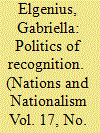

|
|
|
|
|
| Publication |
2011.
|
| Summary/Abstract |
Ceremonial initiatives linked to nation-building projects are highly visible in multiethnic states, where governments seem to have adopted a Durkheimian approach in which ceremonies contribute to the strengthening of communities. However, national ceremonies are not invented or exported to other nations easily, as seen when outlining the pattern of a successful national day. A unifying narrative (sometimes the historical genesis) is significant in the establishment of successful national days, as is the nature of the national day design. The celebrations of the constitution in Norway - and the 77 year struggle to get the Norwegian flag officially recognised - became part of resisting the enforced union with Sweden (1814-1905). Therefore, the growth of Norwegian nationalism must be understood in the context of rival nationalisms in Scandinavia. However, Constitution Day (17 May) has remained a powerful component of Norwegian nationalism long since the constitution ceased to be threatened because of its incorporation in primary and secondary school curricula and, more recently, within the debate on multiculturalism.
|
|
|
|
|
|
|
|
|
|
|
|
|
|
|
|
| 4 |
ID:
185341


|
|
|
|
|
| Summary/Abstract |
This article deploys national anthem and national currency as analytical lenses to disentangle the connection between symbolic politics and nation-building, national identity formation and regime legitimation in Kazakhstan. The study emphasises the role of national symbols—in particular, the national anthem and national banknotes—as important elements of a larger discourse about the nature of Kazakh national identity. The work argues that both the Kazakh national anthem and national currency tenge do not only serve as the main attributes of statehood and economic independence; rather their significance stems from their role as crucial elements in the nation-building process.
|
|
|
|
|
|
|
|
|
|
|
|
|
|
|
|
| 5 |
ID:
141268


|
|
|
|
|
| Summary/Abstract |
In this article I examine the debate over the character of Cyrus the Great in Iran during the last four decades, using it as a prism to view the struggle over the desired balance between religious and ethnic components of Iranian identity. Heated polemics over the historical figure of Cyrus and his legacy reveal undercurrents of Iranian identity dilemmas as well as different and conflicting views of Iranian identity. Beyond a mere historical or religious controversy, the debate over the “right” memory of Cyrus presents an interesting case of shifting emphasis on identity and sources of political inspiration in Iranian society from the late 1960s to the present. Moreover, putting the debate over the ancient king in perspective, there emerges a wider picture of religious adaptation and embrace of what once seemed pagan or secular.
|
|
|
|
|
|
|
|
|
|
|
|
|
|
|
|
| 6 |
ID:
187063


|
|
|
|
|
| Summary/Abstract |
An analysis of the diary of Ihsan Turjman, an Arab soldier who served in the Ottoman army in World War I, and of letters written by B. Zilberman, a Jewish soldier in the British army fighting the Ottomans, reveals common themes that nuance the widely held assumption about the inevitability of the Arab-Jewish conflict in the Middle East.
|
|
|
|
|
|
|
|
|
|
|
|
|
|
|
|
| 7 |
ID:
104119
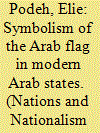

|
|
|
|
|
| Publication |
2011.
|
| Summary/Abstract |
The national flag, anthem and emblem are the three symbols through which an independent country proclaims its identity and sovereignty. Although each state has its distinctive flag, there are similarities in the flags of certain countries, such as in Scandinavia (the cross) and Africa (colours). These symbolise certain propinquity in terms of ideology, culture and history. Similarity is also to be found in the flags of the Arab countries: out of the twenty-two current members of the Arab League, ten share the same colours on their flags (green, white, black and red), while a certain Islamic symbol (eagle, star) in some flags represents the uniqueness of that country. Of the other twelve countries, most rely on one colour of the four (usually red or green) while nine use Islamic symbols (stars, crescent and sword) on their flags. In spite of the importance of this national symbol, the study of the modern Arab flag is almost non-existent. This article explores the modern evolution of the Arab flag and the reasons for the similarities in many Arab flags. In particular, it will deal with the pan-Arab flags of the Hashemites Kingdom of the Hijaz (1916-26), Jordan, Iraq, Palestine, Syria and Egypt.
|
|
|
|
|
|
|
|
|
|
|
|
|
|
|
|
| 8 |
ID:
122860


|
|
|
| 9 |
ID:
114092
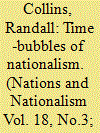

|
|
|
|
|
| Publication |
2012.
|
| Summary/Abstract |
The growth of modern nationalism can be attributed to structural causes, especially the growth of the strong bureaucratic state that penetrates society, creating cultural uniformity and national identity. But structurally based nationalism need not be very intense, or constant; even when institutionalised in periodic formal rituals, it can be routine, low in emotion - even boring. We need to explain sudden upsurges in popular nationalism, but also their persistence and fading in medium-length periods of time. Nationalist surges are connected with geopolitical rises and falls in the power-prestige of states: strong and expanding states absorb smaller particularistic identities into a prestigious whole; weaker and defeated states suffer delegitimation of the dominant nationality and fragment in sudden upsurges of localising nationalities. Passing from macro-patterns to micro-sociological mechanisms, conflict producing solidarity is a key mechanism: dramatic events focus widespread attention and assemble crowds into spontaneous 'natural rituals' - mass-participation interaction rituals, as distinct from formal rituals. Evidence from public assemblies and the display of national symbols following the terrorist attacks of 11 September 2001 (9/11) shows an intense period of three months, then gradual return to normal internal divisions by around six months. Spontaneous rituals of national solidarity are produced not only by external conflict but by internal uprisings, where an emotional upsurge of national identity is used to legitimate insurgent crowds and discredit regimes. Although participants experience momentary feelings of historic shifts, conflict-mobilised national solidarity lives in a 3-6-month time-bubble, and needs to institutionalise its successes rapidly to have long-term effects.
|
|
|
|
|
|
|
|
|
|
|
|
|
|
|
|
|
|
|
|
|